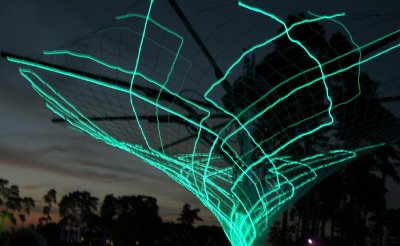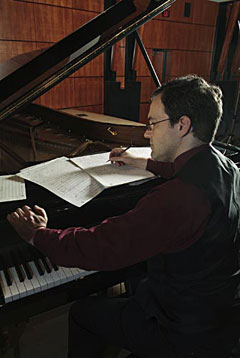The Sunday evening concert explored the range of voices of a piano with four works for piano and orchestra, almost four concertos. Pierre-Laurent Aimard was pianist in three and merely a conductor in the fourth, Dialogues for Piano and Large Ensemble (2003) by Elliott Carter. One result of the differences in attitude (or fashion?) regarding contemporary music between northeast and southwest is that we hear much less of Carter’s music than do you in the more variable climates, so that hearing the work seemed both old and new. Tamara Stefanovich was given the chance to shine as soloist, and she did shine, at turns lyrical, provoking, forceful, quizzical as the kaleidescopic music flowed through her and her fingers into sound. This was a delightful return from intermission. Stefanovich has been impressive in this debut at Ojai, and she deserves some bookings at other venues.
The concert began with Aimard playing the Mozart 8th Concerto, conducting the St. Paul Chamber Orchestra from the keyboard. Douglas Boyd then came on stage to conduct the Ligeti Concerto for Piano and Orchestra (1986), and Aimard was brilliant. I’ve spoken with many Ojai residents (who buy a majority of the tickets, after all), and the programming at the Ojai Festival is as adventurous as they get; for the rest of the year they won’t hear Ligeti (or Carter, for that matter). Yet they come to these concerts with minds willing to listen. The applause for the pianist and for the ensemble was deep and sincerely felt; even some near us who couldn’t quite decide whether or not they liked the work still could recognize that it was pretty impressive. The concert ended in comfort for these uncertains, with Boyd conducting and Aimard playing the Ravel Concerto in G. The slow middle movement seemed to be a lovely match for the Ojai ambience.
The Sunday morning concert was the “feel good” concert of this season, with the Nexus Percussion Ensemble giving us a world exposure. Nexus captured us at the beginning with Steve Reich’s Music for Pieces of Wood (1973), and over two hours later we still wanted more after a medley for xylophone and marimbas of “Bye Bye Blackbird” and “Bye Bye Blues”. (Thank you, Bob Becker.) Someone missed a good special-interest report by not covering the logistics problems associated with getting all of those Nexus instruments from point to point. The three-dozen-or-so devices for bird calls would have been easy to pack, but all of those other instruments would be challenging.
This was a good series of concerts. I wasn’t ready to leave. Next year’s Ojai Festival will have David Robertson as music director and will feature a return of Dawn Upshaw. Put June 5 – 8 on your calendars. The next three months look pretty empty of contemporary music. Why is it that groups and programmers think that summer is a time to stop new music?

 The
The 
 First Jeff Harrington, then David Salvage, and now our very own
First Jeff Harrington, then David Salvage, and now our very own